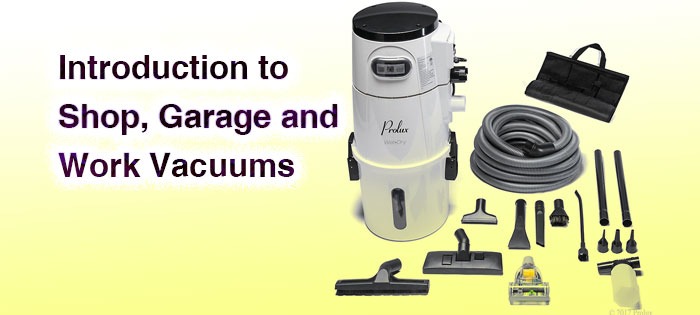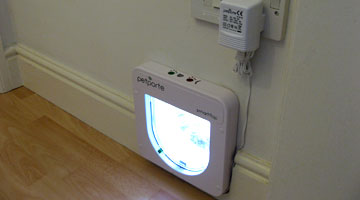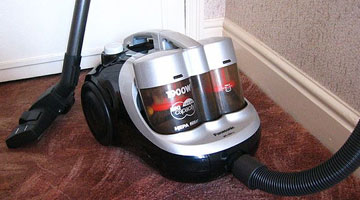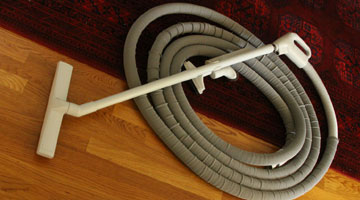Working in shops and garages can be extra messy, so you would need a heavy-duty vacuum to keep them clean. Commercial and garage vacuums are often called shop vacuums, which offer extra power when it comes to cleaning up messes that comes with sawing, drilling, sanding and other shop work. Debris that are too rough, too large or too fine for the typical household vacuum like sawdust, plaster, nails, dirt and drywall dust, and even pools of water can be handled by shop vacs.
Because of their ability to suck wet or dry messes, shop vacs are also called wet/dry vacs. These types of vacuums range in size and power from handy 1-gallon units to heavy 20-gallon models. A small, portable wet/dry vacuum is suitable for occasional minor tasks, and works great as a car vacuum. Meanwhile, a bigger, sturdier and more reliable vacuum machine should be considered by anyone who usually creates DIY and large renovation projects.
Types of Shop/Garage Vacuums
Generally, you have three choices for traditional or wet/dry vacuums suitable for shop and garage use:
1. Hand-held vacuums
This is good for the occasional user and for those looking for budget-friendly vacuums. Hand-held vacuum machines are small and handy, and of course, it has only a small capacity, which means you need to empty the tank frequently if you will be doing extensive work. But if that extensive work is to be done once in a blue moon, this one’s very fine.
2. Wall-mounted vacuums
A popular choice for pros and vacuum junkies, the wall-mounted vacuum is for those who want to invest in better quality machines with higher capacity at a reasonably higher price. As the name implies, they are permanently installed on the wall and are fitted with a long hose to reach different areas such as the workstation, floor or the interior of your car.
3. Portable vacuums
This type usually has canister wheels for smoother mobility and are typically bulkier than the two types. Like the wall-mounted vacuum, this one is chosen because of its quality and capacity.
Power Specifications
Of course, you should choose from the best vacuums in the market (because why not?). In picking any machine, you should check out the specs. In terms of vacuum cleaners, the most important thing to consider is the power specifications.
Manufacturers rate vacuum power by various measurements, and each of them means something different. Here are some of the terms used to describe power specs in vacuums:
1. Peak horsepower (hp): Measures maximum power. It’s not a specific indicator of machine performance, but some vacuums only have this as the sole specification listed. On small machines, choose 1.5 to 2 hp; and at least 3.5 hp on larger ones
2. Power draw in amperes (amp): Look for vacuums with up to 12 amps, but no more than that. A higher amperes could trip a usual household circuit.
3. Air flow in cubic feet per minute (cfm): Indicates how powerfully the motor draws in air, factoring in restrictions like filters and bags. This is the best area of comparison between similar machines. Pick a machine with more than 90 cfm; anything less isn’t very effective.
4. Air watts (W): Combines air flow with sealed suction. Check this spec when comparing two similarly configured machines. Vacuums with 250 air watts and more works best.
5. Sealed pressure in inches of water lift: Measures the motor’s suction power with no air flow. Choose 50 inches or more.
Features
Besides power, there are other important features and capabilities you need to consider to figure out what would work best in your shop or garage.
1. Design and size
Most shop vacuums have similar designs. Their tank sits on the floor on wheels (typically) and can be maneuvered around while you use them. The overall vacuum size depends upon the size of the tank.
Vacuums with lower height are more stable, but it restricts capacity. Taller vacuum machines can tip easily. To test if it does, try pulling the machine by the hose. If it tips, don’t consider buying it – this would only frustrate you in the future.
You might think that bigger is better – but the bigger the tank is, the harder it is to empty when it is full of water. Top rated vacuums in the market have tanks as large as 14 gallons, but they can be too large if you have a small shop or a limited storage space. The most practical size for household use would those with 10-12 gallon capacity. For those who would use it for small tasks only like vacuuming cars, those with tanks as small as 2 gallons would be enough.
Also, consider the material used. Plastic is cheaper and lighter than stainless steel, but steel is more durable.
2. Filters
Filters work in two ways – they effectively trap particles and protect your vacuum motor at the same time. Since you will be dealing with dust more often, it is important to check out what filters does your vacuum of type have. HEPA filters are considered the best option since they can trap particles smaller than 1 micron; and can remove allergens, carcinogenic dust and other harmful particles in the air. But there are also other kinds that can handle fine dust to a certain degree.
Some vacuum models feature a replaceable filter that are disposable after use. There are also machines equipped with a reusable or permanently-installed filter, which means you only have to remove, clean and re-install. Replaceable filters would be ideal and more cost-effective in the long run, but if you don’t like cleaning filters, then go for replaceable ones.
Know how to properly handle and take care of the filters. Also consider how long they would last before they need replacement, and how easy and affordable it is to buy replacements. Some filters are hard to find and can only be availed in the manufacturer’s stores or website.
3. Attachments
To enjoy versatility, choose a garage vacuum that comes with different attachments and accessories. Some come with extended wands for cleaning hard-to-reach areas, brush nozzles for sucking big debris, concentration nozzles and squeegees for wet cleanup, and crevice tools for cleaning corners and cracks. If the vacuum model you would like is lacking attachments that you need, make sure there are compatible accessories available.
4. Hose
While the hose diameters are decided by manufacturers (since they should match the power and capacity of the vacuum), you have some choice on hose length. Obviously, having a longer hose would be convenient, but length actually lessens suction.
Check the durability of the hose. Many newer models have crush-resistant hoses, and it’s better to choose them. Look for a locking connection with the tank and inspect if it is reliable and strong. You don’t want a hose that pulls lose when you tug on the vacuum cleaner.
If you’re buying a wall-mounted vacuum, a longer hose is ideal so that you can reach the places you need to vacuum. But consider if you have space for it, or somewhere it could be wrapped around when not in use.
5. Suction
A good shop or garage vacuum needs to have enough suction to deal with the common wastes like dust, sawdust, screws and food crumbs. The vacuum must be able to suck them up completely without needing to go over same areas over and over again.
6. Noise
Shop vacs are noisy – unmuffled units make noise of 85 decibels and up, while those with mufflers make 60 db. However, new motor technologies can provide powerful performance without creating a loud noise using whisper-quiet operation.
7. Water feature
There are vacuum models that can also work as a pump, which allows you to hook up a garden hose to clear out floods. It’s great to choose a machine like this!
8. Cord length
A short power cord in a portable vacuum could force you to drag around an extension cord. For long cords, make sure you have a built-in cord reel.
9. Wheels
There are models with three wheels, but four wheels are better. Or pick one that has two front wheels that swivel. Outrigger wheels improve stability, but need a wider path for them and are more likely to get tangled.
10. Multi-surface flooring
If your garage or shop has a combination of carpets and hard surface floors, or lots of hard floors, pick a multi-surface vacuum. This allows you to turn the brush roll on and off so you can easily avoid scratching hard floors when transitioning from carpets.
11. On-board storage
There are models with on-board storage, making it easy for the user to have easy access to accessories you might need while vacuuming.
Other Factors to Consider
More than the features, here are other considerations in choosing the shop vac that’s good for you:
1. Multi-functionality
Some vacuums can only perform vacuuming tasks, but the best and cost-effective ones can do other things like blowing or pumping. Some can also act as hand-held vacuums, while some have many different functions that most models don’t have. Think of how you would use your vacuum and choose according to your needs.
2. Stability
Vacuums need to be stable and safe, especially for wall-mount vacuums. The mount should be stable so that it would not fall down with the weight of the wastes in it. Also, remember that you must exert extra care when removing it to empty the tank so that it will not end up on your foot and fall, creating a new mess for you to clean up.
3. Customer feedback
To make it easier for you to decide, read vacuum reviews online and check out the listings of pros and cons for each model you would like to consider. Read manufacturer’s inputs about their products but don’t consider it too much – surely they would only say good things about their models.
4. Budget
Lastly, but more importantly, how much are you willing to spend on a shop vac? Before any other considerations, know the range of machines you can afford. It’s best to look for vacuum deals online and at stores near you. Know when they are having a sale so you can get the bang for your buck.







